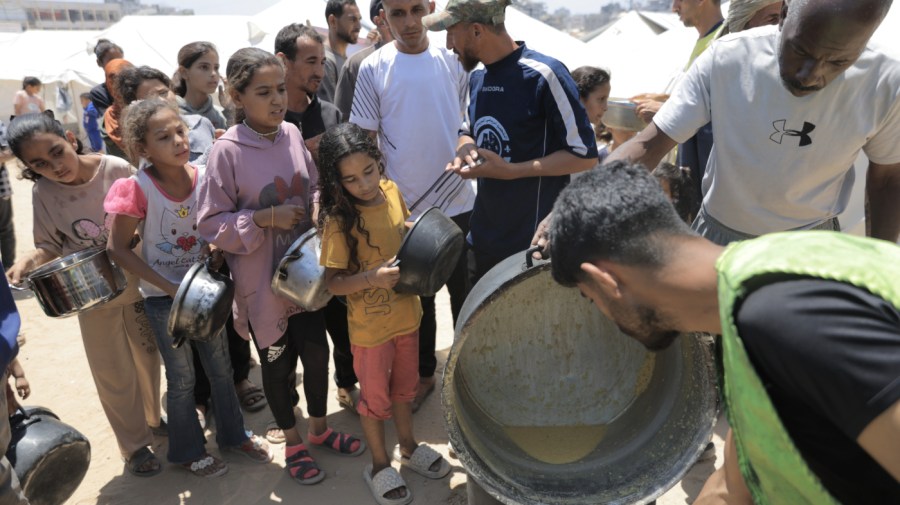Gaza food crisis is ‘worst-case scenario,’ say experts

The worst-case scenario of famine is playing out in the Gaza Strip, the leading international authority on food crisis said in an alert Tuesday as aid workers urge immediate action to avoid thousands of preventable deaths.
The Integrated Food Security Phase Classification, or IPC, issued the alert but stopped short of a formal famine declaration. The warning comes amid international outrage over images of emaciated children and increased reports of death due to starvation in Gaza.
The crisis follows months of Israel’s tightening of humanitarian aid deliveries in the Strip amid its war against Hamas for the Oct. 7, 2023, terrorist attack.
On Monday, President Trump said there was “real starvation” in Gaza, signaling a break with Israeli Prime Minister Benjamin Netanyahu, who had said there was no starvation in Gaza.
The president said the U.S would look into setting up “food centers” in Gaza.
But the administration is drawing scrutiny and criticism for its support of the American-founded Gaza Humanitarian Foundation, which has handled distribution of food in the Strip for months and is criticized for contributing to chaotic, dangerous and undignified aid deliveries with people killed and injured searching for food.
Amid international pressure and France’s declaration it will recognize an independent Palestinian state last week, the Israeli government announced over the weekend it would carry out tactical pauses in fighting to allow for aid distribution.
Jerusalem said it opened up additional corridors for humanitarian assistance and carried out and granted air drops of aid. But humanitarian workers in the Strip say this is far short of the response needed to prevent thousands or potentially tens of thousands of people from dying.
“Air drops are just not a solution. They’re a spectacle. They’re theatrics,” Bushra Khalidi of Oxfam said during a briefing of humanitarian workers organized Tuesday by the nongovernmental organization Save the Children.
“You can’t feed starving children by tossing energy bars from the sky. People have already been injured by falling palettes. They’ve died by falling palettes, and the chaos around these drops only adds to the suffering.”
The Gaza Health Ministry is reporting that 147 people, including 88 children, have died from malnutrition and starvation since October 2023, part of the more than 60,000 people killed since the start of the war. Hamas killed approximately 1,200 people and took 251 hostage in its 2023 attack on Israel.
While the health ministry does not distinguish Hamas militants in the figures, the numbers are widely accepted by the United Nations and other international organizations. Israel estimates it has killed 20,000 Palestinian militants.
The IPC alert said malnutrition has been rising rapidly in the first half of July and has reached the famine threshold in Gaza City. More than 20,000 children have been admitted for treatment for acute malnutrition between April and mid-July, with more than 3,000 severely malnourished, the report said.
“We have many children now in our child protection services saying that they wish to die. In heaven, in paradise, there is food, there is water,” Rachael Cummings, humanitarian director for Save the Children International in Gaza, said in the briefing.
“Yesterday, in the clinic, one of the things that struck me, not only was the sort of visual impact of seeing so many people extremely thin, it was nearly silent … because children cry, but they’re so exhausted, they’re so sick, they’re no longer able to cry. And that, I think for me, was really one of the most significant things I’ve ever seen in my career.”
Tarek Loubani, a Canadian doctor working in Gaza, said the malnutrition numbers are extremely conservative and that death due to malnutrition is only classified when there is no other comorbidity.
“What we’ve seen every other time is that the numbers are about 10 percent of the reality, and probably that’s what we’re looking at here in terms of malnutrition and starvation,” said Loubani, who is also the medical director for the Glia Project, which provides medical supplies to impoverished locations.
Loubani also pointed out that malnutrition is another devastating hardship on top of scarce resources for patients. Families donating blood for relatives wounded in bombings or shootings have difficulty replenishing their own blood supply because “there’s no iron, there’s no nutritious food.”
Loubani said he has lost about 44 pounds living and working in Gaza because there is so little food to eat for medical and aid workers. He said a handful of rice was his recent meal.
“In terms of the physicians and health care workers I work with, they are suffering. Their families are suffering. Everybody here is suffering,” he said.
The IPC report said the sufficient delivery of humanitarian assistance can only be possible with a ceasefire, and that would require scaling up the flow of goods, restoring basic services and ensuring safe, unimpeded access to life-saving assistance.
Trump’s special envoy for peace missions left talks with Hamas last week blaming the U.S.-designated terrorist group as being the obstacle to a deal. He said the administration will consider “alternative options to bring the hostages home and try to create a more stable environment for the people of Gaza.” Hamas holds about 20 living hostages it kidnapped from Israel on Oct. 7 and about 30 bodies.